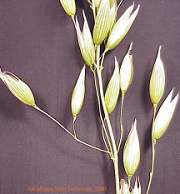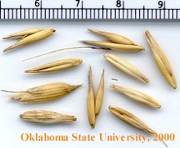Previous Page | Right click this page to print.
Oats
In the U.S., oats is the fourth most important grain. In the U.S., for 2001, the estimated total production of oat grain is 116 million bushels. Oats are grown in the northern regions. Similar to barley, oats can be grown in short growing seasons. The estimated average yield for oat grain is 61.3 bushels per acre. In the U.S. the primary three varieties are white, red, and gray oats. The majority of oats produced are white oats.
Figure 4.14 illustrates oat grain on the head.

Figure 4.15 illustrates oat grain.

Primarily hull varieties are grown. Hull less varieties are rarely grown. And oat groats, the oat seed minus the hull, are generally not a cost-effective feedstuff. In addition to oat grain, oats are also grown for forage.
Oat grain is also classified as a coarse grain.
Table 4.5 summarizes the average nutrient composition of oat grain.
Nutrient
|
Average Composition,
% |
|---|---|
Crude protein |
12.8 |
Ether extract |
4.7 |
Crude fiber |
12.2 |
Ash |
3.7 |
NFE |
66.6 |
Starch |
41.2 |
Oats have the highest fiber content and the lowest starch content of the cereal grains. Therefore, oats have the lowest energy value of all the cereal grains. However, oats are a competitive protein source compared to other cereal grains. The crude protein content in oats is similar to wheat and barley. And compared to the other cereal grains, oats have the most favorable amino acid profile. However, oats remain relatively deficient in methionine, histidine, tryptophan, and lysine. One reason for the improved protein quality of oats over other cereal grains is oats have a low prolamine content. The lipid content of oats is among the highest of the cereal grains, also including corn and triticale. In comparison to the other cereal grains, oats have a high mineral content.
As a result of the soft hull and the high lipid content, oats are a relatively palatable feedstuff. Processing is required to maximize nutritional value. Oats have a slower rate of digestion; which may be either a positive or negative attribute. As a feedstuff, heavy-weighted oats have a higher nutritional value than light-weighted oats. The heavier oats have lower fibrous carbohydrate content and higher nonfibrous carbohydrate content. Oats are commonly fed to younger and finishing swine. For ruminants, oats are primarily fed to younger animals in starter feeds and breeding stock. Oats are a favorable energy source for most horses. In addition to the energy and palatability characteristics, the fiber will limit consumption and avoid nutritional disorders caused by overeating. As the fibrous hull is of minimal energy value to poultry, oats are rarely used as a feedstuff for poultry. As oats have a relatively low energy value, oats are fed to animals with a low energy requirement. Feeding oats as an energy source to animals with high energy requirements, will limit production.
Previous Page | Right click this page to print.